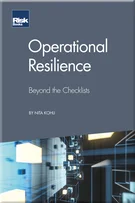Derivation of the joint distribution and capitalisation of operational risk
Rafael Cavestany and Daniel Rodríguez Perez
Introduction
Challenges of operational risk advanced capital models
Part I: Capture and Determination of the Four Data Elements
Collection of operational loss data: ILD and ED
Scenario analysis framework and BEICFs integration
Part II: General Framework for Operational Risk Capital Modelling
Loss data modelling: ILD and ED
Distributions for modelling operational risk capital
Scenario analysis modelling
Exposure-based approaches
BEICFs modelling and integration into the capital model
Hybrid model construction: Integration of ILD, ED and SA
Derivation of the joint distribution and capitalisation of operational risk
Backtesting, stress testing and sensitivity analysis
Regulatory approval report
Evolving from a plain vanilla to a state-of-the-art model
Part III: Use Test, Integrating Capital Results into the Institution’s Day-to-day Risk Management
Strategic and operational business planning and monitoring
Risk/reward evaluation of mitigation and control effectiveness
Appendix 1: Credibility theory
Appendix 2: Mathematical optimisation methods required for operational risk modelling and other risk mitigation processes
Business risk quantification
Having described in Chapter 9 the methods for creating severity and frequency distribution hybrid models with different data elements, we now look at the derivation of the joint distribution and capitalisation of operational risk using hybrid or single-data-element models.
The process described in Chapter 9 delivers a single severity or frequency distributions per operational risk category (ORC), incorporating all the operational loss information contained in internal loss data (ILD), external loss data (ED) and scenario analysis (SA). This input is then used for the determination of the joint distribution and capitalisation of operational risk. Basel Committee on Banking Supervision “Operational Risk – Supervisory Guidelines for Advanced Measurement Approaches” (BCSG-AMA) states: “The techniques to determine the aggregated loss distributions should ensure adequate levels of precision and stability of the risk measures”, also suggesting: “As such, simulation, numerical or approximation methods are necessary to derive aggregated curves (eg, Monte Carlo simulations, Fourier Transform-related methods, Panjer algorithm and Single Loss Approximations)”.
The final output of this
Copyright Infopro Digital Limited. All rights reserved.
As outlined in our terms and conditions, https://www.infopro-digital.com/terms-and-conditions/subscriptions/ (point 2.4), printing is limited to a single copy.
If you would like to purchase additional rights please email info@risk.net
Copyright Infopro Digital Limited. All rights reserved.
You may share this content using our article tools. As outlined in our terms and conditions, https://www.infopro-digital.com/terms-and-conditions/subscriptions/ (clause 2.4), an Authorised User may only make one copy of the materials for their own personal use. You must also comply with the restrictions in clause 2.5.
If you would like to purchase additional rights please email info@risk.net






